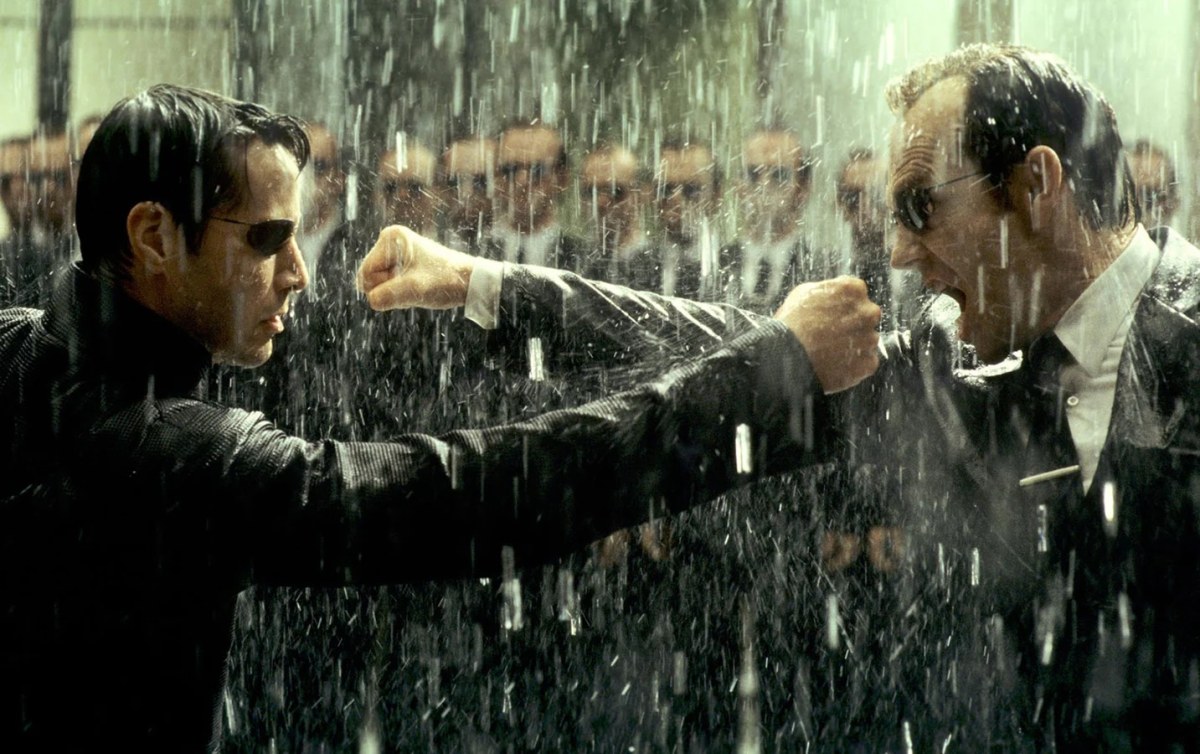The Matrix Reloaded opens with the familiar green streaming code, just like The Matrix. And also just like The Matrix, that code begins to form defined shapes. As the camera whirls around inside the code, the outline of a mechanical gear begins to come into focus. The code depicts rotating cogs, a literal clockwork machine. This is the Matrix sequels in a microcosm: an exploration of the systems that govern the world and keep it ticking over.
The Matrix Revolutions is obsessed with programs. Everything has its function. As critic David Sims has pointed out, Seraph (Collin Chou) is a login screen. Specifically, he is “a Challenge Handshake Authentication Protocol.” Programs that do not serve their functions become monsters. The Oracle (Gloria Foster) explains that ghosts and werewolves are “the system assimilating some program that’s doing something they’re not supposed to be doing.”
At its core, The Matrix was a “Chosen One” narrative for the turn of the millennium. Thomas Anderson (Keanu Reeves) discovered that he was “the One” and that his entire reality was a computer simulation known as the Matrix. According to Morpheus (Laurence Fishburne), the prophecy predicted that the arrival of the One “would hail the destruction of the Matrix, end the war, bring freedom to our people.” Neo would defeat the machines and save the world.
It is a very simple and very comforting narrative, akin to the story of Luke Skywalker (Mark Hamill) in the original Star Wars trilogy, or Frodo Baggins (Elijah Wood) in the Lord of the Rings trilogy. It explains how The Matrix became such a massive cultural phenomenon. The film was followed by two sequels to complete the trilogy, shot back to back between March 2001 and August 2002. It was an approach similar to the one that New Line Cinema had taken with The Lord of the Rings.

In hindsight, The Matrix stands as an oddity in the Wachowski filmography. It is an individualist movie about one person who finds themselves at the center of an epic narrative about how they are the only one who can change or save the world. The Matrix is often discussed as a superhero movie, and understandably so. The film’s closing scene has Neo literally taking flight like a superhero, what Link (Harold Perrineau) would describe in The Matrix Reloaded as “doing his Superman thing.”
This outlook is at odds with the themes of the later films from the Wachowskis. Speed Racer is more interested in the system governing racing than it is with the competition itself. Cloud Atlas is about how “our lives are not our own” and “we are bound to others.” Towards its end, Haskell Moore (Hugo Weaving) warns Adam Ewing (Jim Sturgess) that he “will never amount to anything more than a single drop in a limitless ocean.” Ewing responds, “What is an ocean but a multitude of drops?”
This theme of collaboration against systems of oppression is stronger in their later work. In Jupiter Ascending, Jupiter Jones (Mila Kunis) is a housekeeper that discovers she is secretly royalty, but also that her lineage is a tool that will be exploited by the House of Abrasax as a mechanism to “harvest” all life on Earth. In Sense8, eight very different people from eight very different worlds discover they share a collective consciousness as they try to evade the Biologic Preservation Organization.
The Matrix is different from these Wachowski projects that would follow. It has a complicated legacy. Some of this is undoubtedly down to moral panic, like reports of the movie inspiring horrific copycat crimes. However, there are other lingering issues. Some of the movie’s gun violence is uncomfortable to watch today. Its themes have been co-opted by reactionary movements. On its 20th anniversary, Mark Harris argued, “We live, today, in the anti-reality world The Matrix built.”

The Matrix franchise was also the Wachowskis’ first real brush with big-budget filmmaking. The siblings had encountered problems with their script for the movie that became Assassins, with Lana later describing Richard Donner’s adaptation as “an abortion.” The production of the Matrix sequels was also fraught, with cinematographer Pill Pope noting of the experience, “We weren’t free anymore.” Even doing singular work, the Wachowskis were part of the system.
Freedom is a recurring motif in the world of the Matrix films. The sequels contrast Neo with Agent Smith (Weaving). In The Matrix, Smith was the manifestation of the system, the program tasked with preventing humans from breaking free. At the end of the film, Neo defeats Smith. Smith learns from Neo. “He set me free,” Smith declares in Reloaded. However, Smith is more cynical when he confronts Neo. “We’re not here because we’re free; we’re here because we’re not free.”
The Matrix Reloaded and Revolutions present Smith as a mirror image to Neo. In Revolutions, the Oracle (Mary Alice) explains that Smith is Neo’s “opposite” and “negative.” Smith is a character who has internalized the individualist reading of the original Matrix to such a degree that he can imagine a world built in his image. “You!” gasps Agent Jackson (David A. Kilde). “Yes, me,” Smith responds, transforming Jackson into a copy of himself. “Me, me, me.”
Smith’s duplication of himself and erasure of others is monstrous. It’s presented as an assault, equivalent to death. Neo likens it to his own death at the climax of The Matrix. It contrasts with the way in which the Matrix sequels celebrate unity and collaboration. This is obvious in the maligned and mocked rave sequence in Reloaded, which has been described as “a muddy but sedate orgy.” Bodies mingle. It’s hard to tell where one ends and another begins. It is a multitude of drops.

This rave is intercut with a sex scene between Neo and Trinity. The extent to which actors Keanu Reeves and Carrie-Anne Moss resemble one another is fascinating. As Susanne Kord and Elisabeth Krimmer note, “Trinity is not only androgynous, but looks like the hero. Of similar height and build, and adorned with similar gender-neutral clothing, Neo and Trinity resemble each other to a striking degree.” It’s hard to tell where the One ends and the other begins.
This emphasis on love feels like a response to the coverage of the violence in the original film. The two sequels are decidedly more judicious in their violence, minimizing collateral damage. In the opening sequence of The Matrix Reloaded, Trinity takes down a bunch of civilian guards non-lethally, using her motorbike helmet. In an early sequence in The Matrix Revolutions, mirroring the original’s lobby shootout, Morpheus carefully pushes an unarmed bystander to safety before opening fire.
With all this in mind, it makes sense that the Matrix sequels are decidedly ambivalent about the mythology of Neo. “I just wish… I wish I knew what I’m supposed to do,” Neo admits early in Reloaded. “That’s all. I just wish I knew.” He is uncomfortable with the hero worship. “You saved me!” the Kid (Clayton Watson) tells Neo. Neo responds simply, “You saved yourself.” When Neo does discover what he is supposed to do at the end of Reloaded, it is not comforting.
The Matrix films contrast freedom with control. Early on in Reloaded, Neo understands that even the Oracle must be part of larger mechanisms, that she is “a part of this system, another kind of control.” The Merovingian (Lambert Wilson) taunts Neo that “choice is an illusion, created between those with power, and those without.” Ultimately, Neo discovers that “the One” is just “an anomaly” that has been folded into the larger system. The One ends the conflict, but only so it can start again.

“It was all another system of control,” Neo tells Morpheus at the end of Reloaded. That is all these myths are. The Matrix is a comfort story, but it’s a trap. The sequels argue that true freedom comes from rejecting external systems of control, even the power fantasies of the Chosen One. True freedom comes from choosing, not being chosen. “Why? Why get up?” Smith demands of Neo at the end of Revolutions. “Why keep fighting?” Neo’s answer is very simple — “Because I choose to.”
This is what distinguishes the two Matrix sequels from other epic fantasy sagas like Star Wars or The Lord of the Rings. They are very much about rejecting the sorts of binary distinctions that define so many of these stories: good and evil, us and them. Just as the bodies blur at the rave, the boundaries between human and machine blend together. To make him a more perfect mirror of Neo, Smith even leaves the Matrix to enter the real world in the flesh avatar of Bane (Ian Bliss).
Neo’s consciousness explores the Matrix detached from his body. Neo’s superpowers manifest in reality, as he stops robotic sentinels using the power of his mind. When he is blinded by Smith-as-Bane, he is gifted the ability to see something beyond the material world – orange flames that recall the familiar green streaming code of the Matrix. The worlds are not so different. The machines’ invasion of the underground city of Zion is mirrored in Neo’s trip to “the Machine City” overground.
At the heart of the Matrix sequels is a rejection of the power fantasy of conquering a foe through strength. That is just another system of control. Instead, as the Keymaker (Randall Duk Kim) argues about the climactic action beat in Reloaded, “All must be done as one. If one fails, all fail.” Everyone has their place, their function. Everyone matters. As The Animatrix reveals, the machines did not begin this cycle of violence. “What do you want?” the machines ask Neo at the end of Revolutions. He replies, “Peace.”
The Matrix sequels are messy. Their pacing is uneven. Their computer-generated imagery is uncanny in places. They are indulgent and esoteric. However, they are also bold and ambitious in ways that few films on this scale are allowed to be. They are thoughtful and considered in how they respond to The Matrix. They challenge not just some of the more uncomfortable implications of the original film, but also of Chosen One mythologies in general. Blockbuster cinema is the richer for them.






Published: Dec 8, 2021 11:00 am